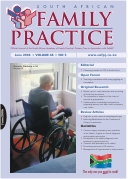Common skin disorders in the elderly
Abstract
Ageing causes a decline in the function of human skin, while factors such as medical conditions, drugs and environmental irritants add to the compromised skin and predispose it to certain conditions. Superimposed on the changes of physiological ageing are changes characterised by chronic sun exposure. Skin neoplasia, whether benign, premalignant or malignant, is more common in the elderly. It is important to identify benign conditions, as it is crucial that lesions with a malignant potential be recognised so that timeous treatment can prevent serious malignancies. Ultraviolet radiation is the major aetiologic factor for the development of skin cancer. Pruritic conditions result from a combination of a declining barrier function and the effects of environmental irritants. Pruritus due to scabies is common in institutionalised older persons. Infective conditions as a result of a combination of altered immunity, predisposing medical conditions (e.g. diabetes) and a variety of drugs used to treat these conditions may affect immune function and homeostasis. Regular scrutiny of the skin will ensure early identification of problems and implementation of a good skin care plan can compensate for failing physiologic function. SA Fam Pract 2006;48(5): 29-34)
Issue
Section
CPD
By submitting manuscripts to SAFP, authors of original articles are assigning copyright to the South African Academy of Family Physicians. Copyright of review articles are assigned to the Publisher, Medpharm Publications (Pty) Ltd, unless otherwise specified. Authors may use their own work after publication without written permission, provided they acknowledge the original source. Individuals and academic institutions may freely copy and distribute articles published in SAFP for educational and research purposes without obtaining permission.

